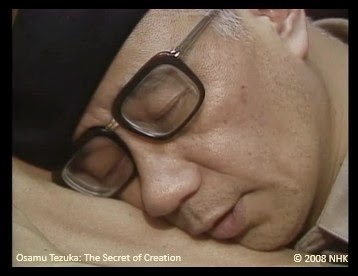To celebrate
the 80th anniversary of the birth of Osamu Tezuka in 2008, the NHK released two documentaries on DVD: Osamu Tezuka:
The Secret of Creation (NHK特集 手塚治虫・創作の秘密
/ NHK Tokushu Tezuka Osamu: Sosaku no
Himitsu, 1986) and Dream Sparkles in
the Sky – Osamu Tezuka’s Summer Vacation (天空に夢輝き 手塚治虫の夏休み, 1995). A
year later, the publisher Ilex Press added Osamu
Tezuka: The Secret of Creation as a bonus DVD to the publication of anime
expert Helen McCarthy’s comprehensive
account of Osamu Tezuka’s life and career: The Art of Osamu Tezuka: God of Manga.
Shot in 1985
and narrated by the familiar voice of NHK broadcaster Isamu Akashi, this documentary was the first to give people a
behind-the-scenes look at how Tezuka worked.
After a brief glimpse of the public face of Tezuka, being honoured by Mari Shimizu (the voice of Astro Boy), in
celebration of his 40 years as a manga-ka,
Tezuka leads the documentary team into his secret workspace: a non-descript mansion (in Japanese this is a type of
apartment) somewhere in the concrete sprawl of Tokyo. Neither his manager, nor his magazine editors
are allowed into his creative space further than the genkan (entranceway where you remove your shoes). The only person allowed any access at all is
his wife. He spends a minimum of five
days a week in this space with only one or two days spent at home.
The mansion apartment is sparsely furnished with
threadbare curtains. The space around
his desk is so narrow that the camera team has to install an angled mirror on
the wall in order to get more than one camera angle of the great man at
work. So as to disturb Tezuka as little
as possible, the camera is controlled via a robots while the crew sits in the
neighbouring room. Tezuka blasts
classical music on a record player while he works, or has a small red
television playing in the background. The
cameras record him for a 24-hour period and we see that instead of going to
bed, Tezuka falls asleep at his desk.
His wife, Etsuko Tezuka, allows the camera crew
into the family home, where they estimate he only spends about 60 days a year,
and on the third floor they discover a museum of character toys and other
keepsakes from his life. The most fascinating
is a childhood manga into which Tezuka’s mother drew a flip book on the corners
of pages. In studying Japanese
animators, I have seen many childhood school books with hand drawn corner flip
books, but usually by the animators. It
is certainly unique for it to have been done by Tezuka’s mother. Tezuka calls the flip book “anime’s point of
origin”.
Tezuka is
shown to be both a workaholic, putting off boarding a plan to France to the
last minute so that he can finish drawings, and someone who misses
deadlines. His editors apparently gave
him the nickname was apparently “Tezuka Osomuchi” (Tezuka slowpoke) and “Disappearing
Saizou”. The documentary presents this as the pressures
of competition and the industry, but I had to wonder how much of this Tezuka
brought on himself. Many animators who
followed Tezuka, most famously Hayao
Miyazaki, blamed him for setting the bar low when it came to production
standards (read
more).
The
highlight of Osamu Tezuka: The Secret of
Creation, for me is his trip to the
first Hiroshima
International Animation Festival. There
is wonderful footage of Tezuka interacting with the legendary French animation
pioneer Paul Grimault, who was the
International Honorary President. Tezuka
would go on to win the top prize at the festival (learn more). Last year, at the 30th anniversary
of the festival, his son Macoto Tezka
honoured his memory by presenting his completion of Part 2 of Tezuka’s
unfinished work Legend of the Forest
(learn
more).
Order Documentary from Japan
As a fan of
Tezuka, this documentary can at times be heartbreaking to watch knowing that the
death of this endlessly creative man looms but four years into the future. During a moment of critical self-reflection about
how he has changed as an artist over the years, Tezuka talks about the fact
that he has so many creative ideas he has yet to put to paper than he could
sell them at bargain prices. Such a
tragedy that he did not have another 40 years to do just that.
Shortly
before the end of the film, Tezuka is shown at work on one of his unfinished projects:
an adaptation of the bible for broadcast on Italian television (RAI). He’s having trouble keeping the project on
schedule and stares at the clock on the wall.
The camera crew asks him if he is scared of the clock, and he says, “Not
exactly scared, I just want more time.” Unfortunately, he ran out of
time, but Osamu Dezaki eventually
finished the series for Tezuka Productions. It aired first on TV in Italy in
1992 under the title In principio: Storie
dalla Bibbia, and then five years later on Japanese TV under the title In
the Beginning: The Bible Stories (手塚治虫の������聖書物語 / Tezuka Osamu no Kyūyaku
Seisho Monogatari, 1997).
45 minutes
Documentary Crew <スタッフ>:
構 成:小原 誠
撮 影:高野英二
照 明:宮川正夫
技 術:酒井弘文/堀口弘幸
編 集:松本哲夫
効 果:萩野勝男
制 作:福島祥行/小河原正己
2015 Cathy
Munroe Hotes


































